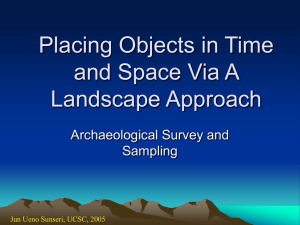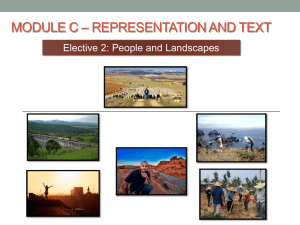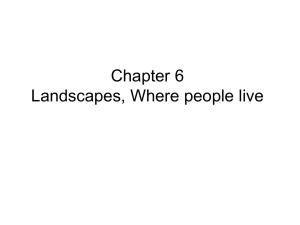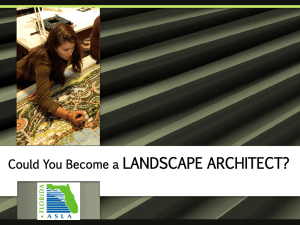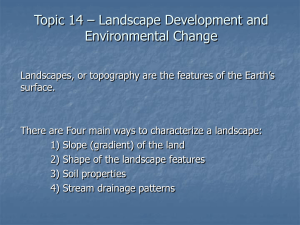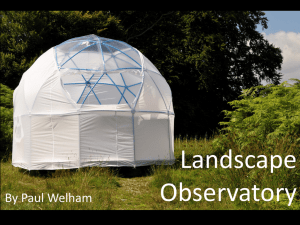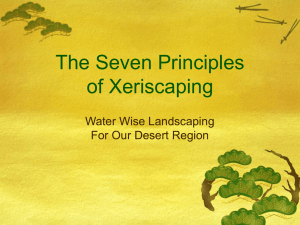Land Uses & Landscapes - Department of Geography, Environment
advertisement
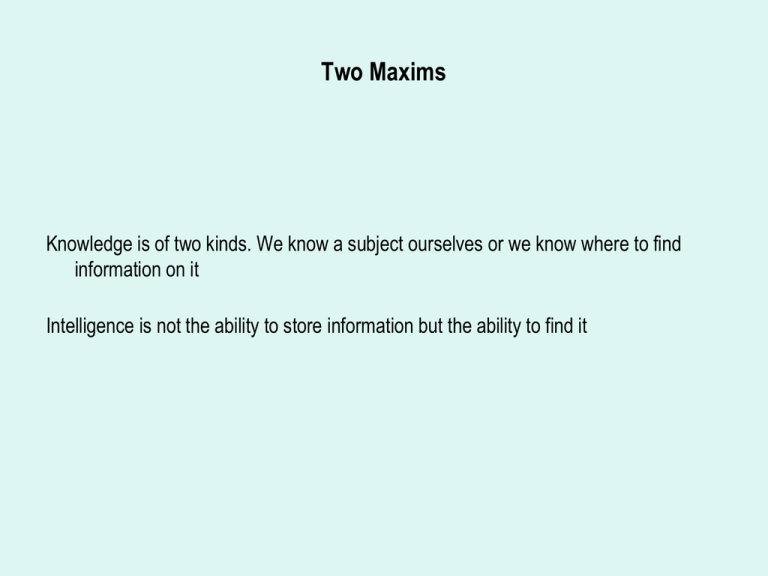
Two Maxims Knowledge is of two kinds. We know a subject ourselves or we know where to find information on it Intelligence is not the ability to store information but the ability to find it My Interests – as a Geographer For the most part my intellectual interests are descriptive, attempting to document how the U.S. landscapes has evolved by focusing on the institutional forces that provide the framework for virtually all human behaviors • How societies organize • space – basic divisions and evolution • behavior – basic principles and evolution • How entities – individuals, groups of individuals, governments – with the right to use land, landowners, exercise those rights to produce goods and provide services and thus create landscapes – the visible effects of human behavior Pedagogy - PowerPoint presentations My lecture notes, which you may not fully understand without my narrative Practical way of organizing my thoughts Convenient method of displaying the information I think is important – taken from a variety of sources A bibliography for the class You will notice that I concentrate on certain aspects of public policy What I talk about represents what topics I find interesting, topics not covered or not covered “appropriately” in other geography courses The nature of landscape (A)ny landscape is an artifact - an object made by man. Its condition, rightly seen, reveals a society's culture as directly as does a novel or a newspaper or a Fourth of July oration because today's environment, the "natural part included, is synthetic (Roderick Nash The American Environment: Readings in the History of Conservation, 1968 ix) Our human landscape is our unwitting autobiography, reflecting our tastes, or aspirations, and even our fears, in tangible, visible form.... All our cultural warts and blemishes are there, and our glories too; but above all, our ordinary day-to-day qualities are exhibited for anybody who wants to find them and knows how to look for them (Peirce Lewis "Axioms for reading the landscape, some Guides to the American Scene" in Donald Meinig (ed) Interpretations of Ordinary Landscapes (New York, Oxford University Press, 1979 23) The nature of landscape (A)ny landscape is an artifact - an object made by man. Its condition, rightly seen, reveals a society's culture as directly as does a novel or a newspaper or a Fourth of July oration because today's environment, the "natural part included, is synthetic (Roderick Nash The American Environment: Readings in the History of Conservation, 1968 ix) Our human landscape is our unwitting autobiography, reflecting our tastes, or aspirations, and even our fears, in tangible, visible form.... All our cultural warts and blemishes are there, and our glories too; but above all, our ordinary day-to-day qualities are exhibited for anybody who wants to find them and knows how to look for them (Peirce Lewis "Axioms for reading the landscape, some Guides to the American Scene" in Donald Meinig (ed) Interpretations of Ordinary Landscapes (New York, Oxford University Press, 1979 23) Landscapes are political statements representing the outcome of rational decisions of individuals, corporations, and governments Landscapes are political statements representing the outcome of rational decisions of individuals, corporations, and governments To truly appreciate landscapes and places – particular landscapes in particular locations – we must understand; How governments reach consensus about their role and responsibilities and so organize behavior and space and • Enact statutes – the legislative process • Promulgate rules – the administrative (regulatory) process • Issue judicial opinion – the judicial process (litigation) Landscapes are political statements representing the outcome of rational decisions of individuals, corporations, and governments To truly appreciate landscapes and places – particular landscapes in particular locations – we must understand; How governments reach consensus about their role and responsibilities and so organize behavior and space and • Enact statutes – the legislative process • Promulgate rules – the administrative (regulatory) process • Issue judicial opinion – the judicial process (litigation) How individuals, organizations, and governments • Help formulate the consensus and statutes, rules, and judicial opinions • React to the statutes, rules, and judicial opinions A Heuristic Device How the various branches of the federal government reach consensus How such consensus gets articulated into public policy How individuals, corporations, and other governments contribute to policy How individuals, corporations and other governments react to policy How can we explain the behavior of dairy farmers and milk producers? A simple suggestion Federal Government • Statutory Law regarding milk production, marketing, and consumption • Administrative Law regarding milk production, marketing, and consumption • Case Law regarding milk production, marketing, and consumption Milk Producers – dairy farmers, dairy companies Milk, Butter, Cheese Consumers Deconstruct Landscape The visible evidence of human activities on the “land surface” – most usually associated with a particular sort of behavior – “land use” Carried out under the impetus of law/public policy Activities – farming Artifacts – structures, installations, facilities Collection of artifacts – farms, dairy farms, cities, military bases Goods produced – automobiles, drugs, cosmetics, weapons of mass destruction, paperclips • Services provided – banking, mass transit, education, transportation, public safety • • • • A Paradigm for Landscape Activity Goods Service Artifacts Landscape Dairy Farms Activity - dairy farming Cows, milk (hay, corn) Barns, fences, silos, corn cribs … Deconstruct Public Policy – Law – a social construct for effecting behavior • • • Defines goals – establishes a reason for specific types of behavior Defines, promotes, and rewards certain types of behavior Defines, prohibits, and penalizes – implicitly or explicitly – other types of behavior Provides • • A context in which individuals, corporations, and governments decide to behave and subsequently act Cues for subsequent rational behavior – provide opportunities and impose constraints A Paradigm for Landscape Federal Legislation Federal Regulation Federal Judicial Opinions Law Public Policy Activity Goods Service Artifacts Landscape Primary Sources for the Geography of the United States Statutes at Large (GPO) Statutes at Large (Hein Online United States Code (GPO) United States Code (Legal Information Institute) Primary Sources for the Geography of the United States Federal Register (GPO) Code of Federal Regulations (GPO) Code of Federal Regulations (Legal Information Institute) Primary Sources for the Geography of the United States Supreme Court opinions How we explain the behavior of dairy farmers? Federal Statutory Law regarding milk production, marketing, and consumption • Dairy Market Enhancement Act of 2000 – one such statute, act Administrative Law regarding milk • Regulations of the US Department of Agriculture – regulations, rules Case Law regarding milk • Hillside Dairy Inc. et al v William J Lyons Jr., Secretary California Department of Food and Agriculture et al 123 S. Ct. 2142 (June 2003) – one such court case The actions of large milk companies – Land O’Lakes – and the federal law influencing the way in which they behave Deconstructing Public Policy – Law Congress Legislative Mandate Agency Legislation Regulation LAW Deconstructing Public Policy – Law Congress Legislative Mandate Agency Legislation Regulation Courts LAW Deconstructing Public Policy – Law Congress Legislative Mandate Agency Legislation Regulation Courts LAW Deconstructing Public Policy – Law Congress Legislative Mandate Agency Legislation Regulation Courts LAW A Paradigm for Landscape Federal Legislation Federal Regulation Federal Judicial Opinions Law Public Policy Activity Goods Service Artifacts Landscape Evaluation Economic indices Contingent value Tobacco A Paradigm for Smoking The Family Smoking Prevention and Tobacco Control Act 2009 Lobbying FDA FDA v. Brown & Williamson Tobacco Corp. 2000 Smoking Lobbying A Paradigm for Landscape Federal Legislation Federal Regulation Federal Judicial Opinions Organization of Space Law Public Policy Activity Goods Service Artifacts Landscape Organization of Behavior Evaluation Economic indices Contingent value The United States landscapes reflect • • • Multiple iterations of public policy – virtually each Congress – involving the continuous often acrimonious debate about the role and responsibilities of governments Myriad decisions made by individuals, organizations and governments operating within the framework of opportunities and constraints • What goods to produce & how to produce them • What services to provide & how to provide them Relationships between individuals, organizations, and governments All landscapes reflect a past and a present All landscapes provide a basis for a future They embody incredible details – about the past, present and future – about our fears and aspirations It’s hard to remember the objective was to drain the swamp At any one point in time landscapes are ambiguous and contradictory They only make sense in the appropriate temporal and spatial context Muddling Through – Disjointed Incrementalism We change our mind about the role & responsibilities of government Governments accept responsibilities that the private sector is not willing or not able to accept Private sector provides services that governments cannot fully provide – private prisons, security overseas, school bake sales Vioxx Drug Recalls Wetland Protection Bicycling Smoking DDT Public Policy Outcomes Artifacts – structures, installations, facilities Goods and Services The Male Love Affair with Petroleum! Military Industrial Complex Spatial distributions Spatial distributions Temporal distributions Take-home Points Landscapes are political statements Landscapes embody the past and the present and are the basis for the future Landscapes are the product of “shared” endeavors between governments and the “private” sector (I’d call it a product of socialism but ….) There may be no such thing as private enterprise in the United States My Propositions Need a way of thinking about landscapes because • • • There are a bewildering array of landscapes There are an astounding variety of goods and services They all contain elements of the past, present, and future A Paradigm for Landscape Federal Legislation Federal Regulation Federal Judicial Opinions Organization of Space Law Public Policy Activity Goods Service Artifacts Landscape Organization of Behavior Evaluation Economic indices Contingent value Organization of Space The Organization of Space The Nature of Places – Jurisdictional Units, Governments Organized spatially United States • Horizontally • Vertically Minnesota Organized temporally Metropolitan Council • Boundary changes Ramsey County Historically • Increasing number • Decreasing size St. Paul White Bear Township Organization of Space – Jurisdictions What is the size of the United States? What is the size of the United States? Where would you look for information? What is the size of the United States? Where would you look for information? “If you are a U.S. citizen or resident alien, the rules for filing income, estate and gift tax returns and for paying estimated tax are generally the same whether you are living in the U.S. or abroad” Section Township Subdivision Plat How do you choose a topic? Your career goals Your intellectual interests Your other interests USA.gov
